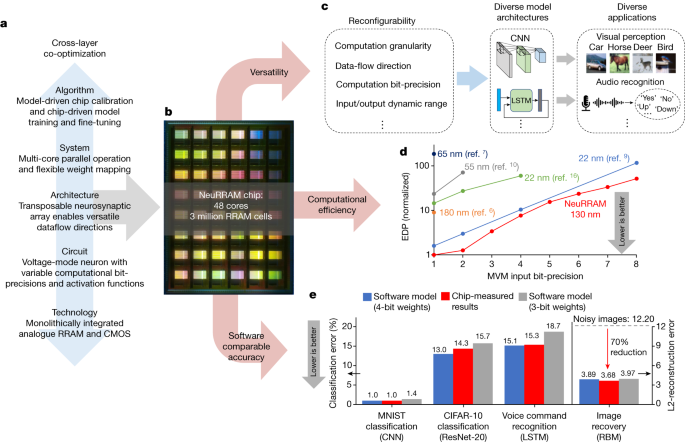2022-08-25 ピッツバーグ大学
「コンピュート・イン・メモリー」チップは、より安全で高速かつ安価、さらには環境にも優しい新しい人工知能の利用方法を開発するための一歩となる。
コンピュート・イン・メモリ技術により、AIをクラウドから直接デバイスにオフロードすることが可能になり、コンピュータの別々のパーツ間でデータを移動させるという電力消費の多いプロセスを省くことができる。
研究チームが『Nature』に発表した新しい設計は、スマートなウェアラブルやドローンなどのバッテリー駆動のデバイスでも使用できるほど効率的である。
<関連情報>
- https://news.engineering.pitt.edu/this-new-chip-could-lead-to-faster-more-secure-ai/
- https://www.nature.com/articles/s41586-022-04992-8
抵抗変化型ランダムアクセスメモリを用いたコンピュートインメモリチップ A compute-in-memory chip based on resistive random-access memory
Weier Wan,Rajkumar Kubendran,Clemens Schaefer,Sukru Burc Eryilmaz,Wenqiang Zhang,Dabin Wu,Stephen Deiss,Priyanka Raina,He Qian,Bin Gao,Siddharth Joshi,Huaqiang Wu,H.-S. Philip Wong & Gert Cauwenberghs
Nature Published:17 August 2022
DOI:https://doi.org/10.1038/s41586-022-04992-8

Abstract
Realizing increasingly complex artificial intelligence (AI) functionalities directly on edge devices calls for unprecedented energy efficiency of edge hardware. Compute-in-memory (CIM) based on resistive random-access memory (RRAM)1 promises to meet such demand by storing AI model weights in dense, analogue and non-volatile RRAM devices, and by performing AI computation directly within RRAM, thus eliminating power-hungry data movement between separate compute and memory2,3,4,5. Although recent studies have demonstrated in-memory matrix-vector multiplication on fully integrated RRAM-CIM hardware6,7,8,9,10,11,12,13,14,15,16,17, it remains a goal for a RRAM-CIM chip to simultaneously deliver high energy efficiency, versatility to support diverse models and software-comparable accuracy. Although efficiency, versatility and accuracy are all indispensable for broad adoption of the technology, the inter-related trade-offs among them cannot be addressed by isolated improvements on any single abstraction level of the design. Here, by co-optimizing across all hierarchies of the design from algorithms and architecture to circuits and devices, we present NeuRRAM—a RRAM-based CIM chip that simultaneously delivers versatility in reconfiguring CIM cores for diverse model architectures, energy efficiency that is two-times better than previous state-of-the-art RRAM-CIM chips across various computational bit-precisions, and inference accuracy comparable to software models quantized to four-bit weights across various AI tasks, including accuracy of 99.0 percent on MNIST18 and 85.7 percent on CIFAR-1019 image classification, 84.7-percent accuracy on Google speech command recognition20, and a 70-percent reduction in image-reconstruction error on a Bayesian image-recovery task.



